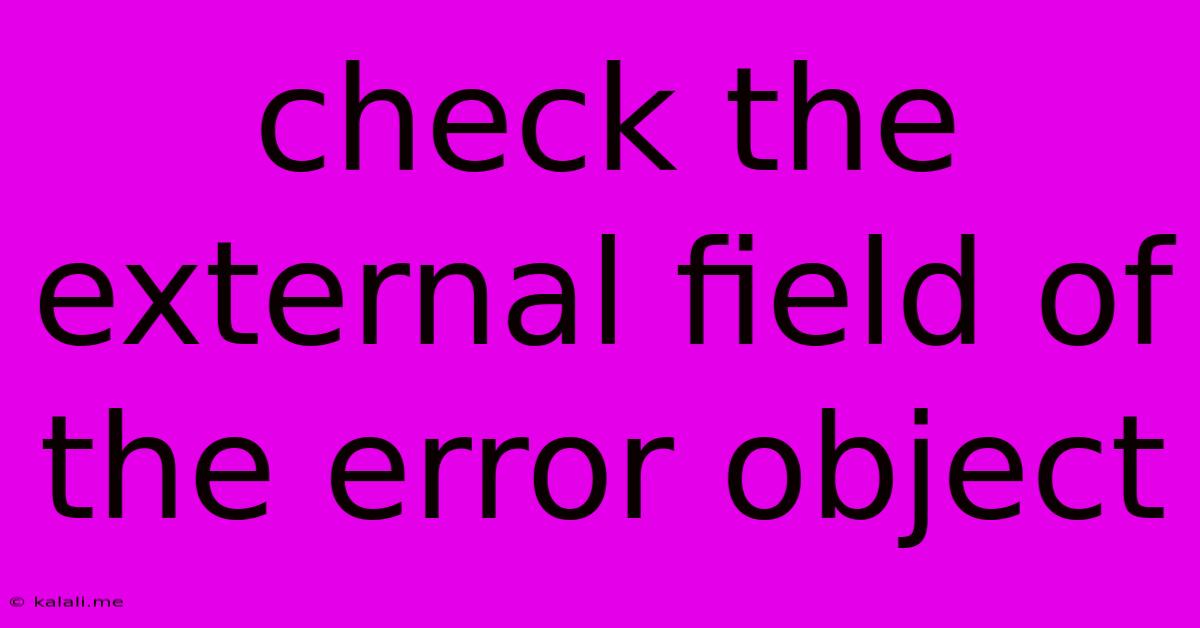Check The External Field Of The Error Object
Kalali
May 25, 2025 · 3 min read

Table of Contents
Decoding the Mystery: How to Check the External Field of the Error Object
Error handling is a crucial part of robust software development. Understanding the intricacies of error objects, particularly their less-frequently accessed fields, is vital for debugging and improving application resilience. This article delves into the often-overlooked external field within error objects, explaining what it is, when it's used, and how to effectively check its contents for better error diagnosis. This knowledge empowers developers to create more reliable and maintainable applications.
The external field within an error object is not standardized across all programming languages or frameworks. Its presence and purpose are highly context-dependent, often relating to external services, libraries, or system calls. Think of it as a container for additional error information that isn't directly generated by your code's internal logic. This extra information can be invaluable when troubleshooting issues stemming from external dependencies.
What Kind of Information Might Be in the external Field?
The contents of the external field vary greatly depending on the source of the error. Here are some examples:
-
API Response Data: When interacting with external APIs, the
externalfield might contain the raw response from the API, including status codes, headers, and the body of the response. This can help pinpoint the root cause of the error on the server side. -
System Call Errors: When interacting with the operating system (e.g., file I/O, network operations), the
externalfield might store details about the system-level error that occurred, such as error codes and system messages. -
Third-Party Library Errors: Errors originating from third-party libraries may use the
externalfield to include specific details about the error from that library, allowing for more precise debugging within that library's context. -
Custom Error Data: Some frameworks or libraries might use this field to extend error reporting with application-specific data, providing additional context for error handling within the application's own logic.
How to Check the External Field
The method for accessing the external field differs significantly between programming languages and error handling mechanisms. There's no single universal syntax. The following examples illustrate common approaches:
Example (Conceptual):
Let's assume a hypothetical scenario in a JavaScript environment:
try {
// Code that might throw an error
const response = await fetchExternalAPI();
} catch (error) {
if (error.external) {
console.error("External Error Details:", error.external);
//Further processing based on error.external content
if(error.external.statusCode === 404){
//Handle 404 specifically
}
} else {
console.error("Internal Error:", error);
}
}
This example checks for the existence of the external property before accessing it, preventing potential errors if the property is not present. The specific structure of error.external will depend on the API or system call that generated the error.
Language-Specific Considerations:
You'll need to consult the documentation for your specific programming language, framework, and libraries to understand how error objects are structured and how to access the external field (if it exists). For instance, Python's exception handling may have a different approach than Node.js's or Java's.
Best Practices for Handling External Error Fields
-
Always Check for Existence: Before accessing the
externalfield, explicitly check if it exists to prevent runtime errors. -
Log Thoroughly: Log both the main error and the contents of the
externalfield for detailed debugging information. -
Contextual Error Handling: Use the information in the
externalfield to tailor your error handling logic and provide more informative error messages to users. -
Security Considerations: Be mindful of sensitive data that might be included in the
externalfield. Avoid logging or displaying sensitive information directly to users. Sanitize and filter data appropriately.
By understanding and effectively utilizing the external field of error objects, developers can significantly improve their application's robustness and debugging capabilities, leading to better software quality and a smoother user experience. Remember that the key to success lies in understanding the specifics of your environment and adapting these techniques accordingly.
Latest Posts
Latest Posts
-
What Is A Quarter Of A Million
Jul 02, 2025
-
Which Of The Following Is True Concerning A Dao
Jul 02, 2025
-
How Long Can Catfish Live Out Of Water
Jul 02, 2025
-
Is Kanye West Related To Cornel West
Jul 02, 2025
-
Olivia Needs To Provide A Visual Summary
Jul 02, 2025
Related Post
Thank you for visiting our website which covers about Check The External Field Of The Error Object . We hope the information provided has been useful to you. Feel free to contact us if you have any questions or need further assistance. See you next time and don't miss to bookmark.